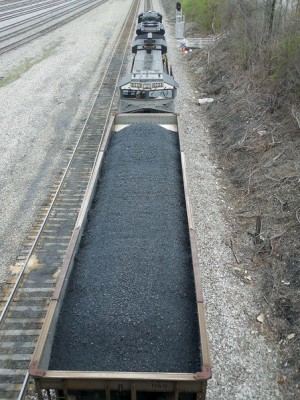
The eastbound Norfolk Southern coal train shown here as it passed beneath the Grant Street Bridge in Bluefield is likely bound for the NS port facility at Lambert’s Point. New statistics reveal a dramatic drop in the number of active coal miners in West Virginia
BLUEFIELD, W.Va. — Each week, the West Virginia Coal Association sends out an e-mail blast called “Coal Bits.” The weekly newsletter contains information about up-coming events, symposiums, legislative updates and such as well as the current statistical information supplied by the federal Energy Information Agency, the National Mining Association and the West Virginia Office of Miners’ Health, Safety and Training.
It doesn’t take a statistician to extrapolate that the numbers in the coal industry remain distressed, but there was some data in this week’s report from the Office of Miners’ Health, Safety and Training that seemed rather startling. From Jan. 1, through March 26, the actual number of active coal miners in West Virginia dropped from 18,200 to 15,604. Of that number, 12,697 were working in underground coal mines and 2,907 were working at surface mines.
Taylor started working in the mines in 1976 fresh out of Virginia Tech. “In the nearly 40 years that I’ve been in this business, this is the worst I’ve ever seen it,” he said.
“What bothers me the most is that we’re losing our most valuable asset — our labor force,” Taylor said. “These experienced coal miners are good workers who may be forced to leave homes their families have been in for generations. They’re good workers, so they will likely find work. When they do, we may never get them back.”
In addition to the immediate void that appears as a result of 2,596 coal miners who dropped from the active category during the first quarter of calendar year 2015, Taylor also expressed his concern over the residual impact that the loss of the workers will have on the region.
“Bill Raney (president of the West Virginia Coal Association) often talks about the number of indirect jobs that depend on every coal mining job,” Taylor said. “I think the figure he quotes is seven other jobs for each one coal miner. I’ve heard other estimates of one or two up or down from the seven jobs, but it is a real impact. Those seven jobs include welders, retail sales associates, school teachers, pharmacists, automobile mechanics and preachers — every time we lose just one coal miner.”
The southern West Virginia and southwestern Virginia coalfields are the heart of the metallurgical coal fields — an area that the EIA data seems to indicate is hardest hit. The EIA report indicated that steel output for the first week in April was down 13.7 percent globally compared to a year ago…





